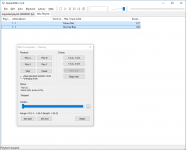Great result and hearing abilities, Karl! So should I start a thread on audibility of speaker distortion? I assume it might be a flame thread, though.
You can never judge or guess what the reactions may be until you try. This thread for example has been a winner, nearly 500 good quality replies in less than two weeks.
See what you can come up with, and if it looks viable then give it a try.
Thank you Karl, I have done some job and opened a new thread on speaker non-linear distortion test:
Audibility of speaker nonlinear ditortion - test
Audibility of speaker nonlinear ditortion - test
Maybe you are interested in this new article:
Traditional Distortion Measurements are Hard to Understand by John Siau
https://benchmarkmedia.com/blogs/application_notes/interpreting-thd-measurements-think-db-not-percent
Traditional Distortion Measurements are Hard to Understand by John Siau
https://benchmarkmedia.com/blogs/application_notes/interpreting-thd-measurements-think-db-not-percent
If you are a well-trained geek you will recognize that each added leading zero represents a 20 dB improvement.
When distortion reaches 1% it is just 40 dB lower than the music. When distortion reaches 0.1% it is 60 dB lower than the music. When distortion reaches 0.01% it is 80 dB lower than the music. Obviously the 40 dB, 60 dB and 80 dB figures are easier to understand than 1 %, 0.1% and 0.01%.
Summary – A Conservative Approach to Transparency
If our goal is to build transparent audio systems, there should be no audible distortion. If we keep the total distortion at or below the threshold of hearing, we can guarantee that it will be inaudible. When this level of performance is achieved, we are not relying on masking to hide the distortion. Instead, the distortion is inaudible because it is reproduced at levels that are below the threshold of hearing.
If we want to listen at 80 dB, peaks will reach about 100 dB. At this playback level, the distortion must be lower than -100 dB (0.001%) to absolutely guarantee that it is inaudible.
This very conservative approach to transparency eliminates the masking guesswork.
But this thread is not about designing the excellent amplifier. Opposite is true, it is about crossover distortion hardly seen in a good amp. That's why the chipamp was used. And listeners were asked to give an ABX proof that they were able to hear 0.01 - 0.1% crossover distortion. There are another threads about amplifier designing for best parameters.
Several posts ago, I mentioned about a possible "acoustical" measurement (for ~400Hz file), using a microphone attached to headphone. I don't have a dummy head, so I improvised.
I unable to measure this distortion acoustically. My environment is too noisy (city downtown). Is at least 10-15dB under room noise. A single tone below ~15dB is audible/discernible, depending to frequency; the brain makes correlation. I can imagine that composite distortion impossible to hear under noise.
So it's explain why I don't perceived differences

Perhaps at 3:00AM...
I unable to measure this distortion acoustically. My environment is too noisy (city downtown). Is at least 10-15dB under room noise. A single tone below ~15dB is audible/discernible, depending to frequency; the brain makes correlation. I can imagine that composite distortion impossible to hear under noise.
So it's explain why I don't perceived differences
Perhaps at 3:00AM...
Sorry for gravedigging an old thread, but this is a super interesting topic. After reading through it I've seen people mention that it's not possible to discern the normal biased Texan simulation. I think I've managed to do this using the original song (Steely Dan I think?), listening for the snare drum transients. Both the low bias and the normal bias files hit a tiny bit softer, and since the original recording is so dynamic, it's sometimes noticable. The most difficult thing was probably finding a balance of listening to the files close enough after each other and at the same time trying to find the differences immediately, because any repeated listening tired my ears/brain super fast.
With the Bach violin I heard nothing in the violin itself - I don't listen to classical music much, so I'm not really trained for this. I was correctly able to recognize the low bias version by noise profile at the very beginning, but that's it, so I didn't even try the normal bias.
With the Rotel the 1 kHz tone is obvious, but the music was not obvious at all for me. I didn't listen to it very long, may try again some other day to identify other sounds to listen for, but the only difference I heard was with hihats - in one file they sounded more dry, in the other they sounded more resonant - I think that was 7 of 9. The difference was super sublte though, so when I got to 7/9, considering the filename I decided that's enough.
With the Bach violin I heard nothing in the violin itself - I don't listen to classical music much, so I'm not really trained for this. I was correctly able to recognize the low bias version by noise profile at the very beginning, but that's it, so I didn't even try the normal bias.
With the Rotel the 1 kHz tone is obvious, but the music was not obvious at all for me. I didn't listen to it very long, may try again some other day to identify other sounds to listen for, but the only difference I heard was with hihats - in one file they sounded more dry, in the other they sounded more resonant - I think that was 7 of 9. The difference was super sublte though, so when I got to 7/9, considering the filename I decided that's enough.
Attachments
- Status
- This old topic is closed. If you want to reopen this topic, contact a moderator using the "Report Post" button.
- Home
- General Interest
- Everything Else
- Test your ears in my new ABX test
